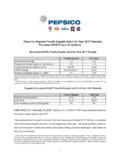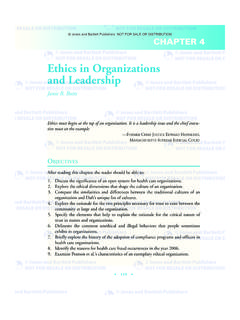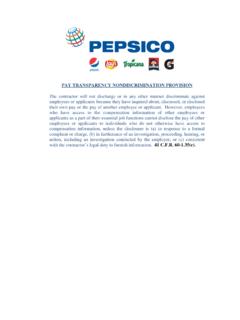Transcription of The Triple Bottom Line Explained - Angela Lewis …
1 The Triple Bottom line Explained : The Triple Bottom line refers to a how a corporation deals with and reports on its impact and behaviour in respect to people, planet and profit. It reflects a corporation's greater transparency and accountability in its public reporting, communication and disclosure in regard to how the corporate entity performs in environmental, social and economic dimensions While there is no single universally accepted definition of TBL reporting, in a sentence it can be defined as corporate communication with stakeholders that describes the company's approach to managing economic, environmental and social social dimensions of its activieis. It is also known as corporate social responsibility', though some prefer to use the word sustainability' as more encompassing, as they argue that responsibility emphasises the benefits to social groups outside the business, whereas sustainability gives equal importance to the benefits enjoyed by the corporation itself.
2 Sustainable in this definition also refers to development that must not reduce options open to future generations. However, responsibility and sustainability are both used to refer to a company's obligations to society at large. The phrase ''corporate social responsibility'' (CSR) is used to describe why, when, and how businesses manage their social, environmental, and economic aims and performance. It is an expression of the belief that it is not enough for a company simply to profit its owners. Rather, CSR holds that a company also must ensure that it does little or no harm to, and preferably helps, its workers, the environment, and the communities in which it operates. As such, CSR is a balancing act between the interests of a company's various ''stakeholders''. including shareowners, executives, employees, communities, and customers. It also is referred to as ''good corporate citizenship'', ''compassionate capitalism'', and ''business ethics''.
3 CSR has evolved in diverse ways for different companies, industries, and societies. In the United States, Latin America and Southeast Asia, for example, much CSR involves donations to social and artistic causes and other such acts of corporate philanthropy. In Europe, where charity is regarded as a peripheral aspect of corporate operations, debate about CSR has focused on the environmental and social impact of companies' business functions. The concept of the Triple Bottom line was proposed by John Elkington, who suggests that businesses need to measure their success not only by the traditional Bottom line of financial performance & profit, but also by their impact on the broader economy, the environment and on the society in which they operate. In conducting their businesses, companies use not only financial resources (investment dollars, sales revenues), but also environmental resources (water, energy, raw materials) and social resources (employee's time and talents, infrastructure provided by govt agencies).
4 His argument was that a sustainable business out to be able to measure, document ad report a positive return on investment across all three Bottom lines, as well as showing the benefits that stakeholders receive along the same three dimensions. -1- Basically, Triple Bottom line (TBL) reporting is meant to capture, describe and measure the impact of the organisation's activities on the world. The Triple Bottom line exists as a kind of balanced scorecard that captures in numbers and words the degree to which any company is or is not creating value for its shareholders and society. Economic (profit) Environmental (planet) Social (people). Sales, profits return on investment Air quality Labour practices Taxes paid Water quality Community impacts Monetary flows Energy usage Human rights Jobs created Waste produced Product responsibility In terms of; People - social justice, Planet - environmental issues Profit - economy prosperity.
5 Stakeholders could be: shareholders, investors, employees, custoemrs, suppliers, the community and government. Benefits Enhancement of of reputation and brand Effective communication with stakeholders on one or more of TBL dimensions can play an important role in manageing stakeholder perceptions and so protect and enhance corporate reputation (look what happened to wheat board shares). Securing a social licence to operate This is kind of like reputation, an informal community and stakeholder support for the organisation's operations communities are likely to be more more supportive of companies that communiate openly & honestly about tehir performance in relation to environ, social & economic factors. Attraction and retention of high calibre employees The publication of TBL information can play a role in positionng an employer as an employer of choice, which can ehance employee loyality, reduce turnover attract knowledge/gold collar workers.
6 Reduced risk profile When TBL reporting takes place a company shows its commitment to minimising risk in times of increasing litigation, where due diligence can be established and a company establishes risks, they can be better managed. In turn, this improves stakeholder relations and makes it easier to attract investment capital and therefore positively affect the share price. Identification of potential cost savings TBL reproting involves the collection, collation and analysis of data on resource and material usage and the assessment of vusiness processes. This can actually help a company to better identify oportuntieis for cost savings through more efficient use of resources and materials. -2- Increased scope for innovation In the process of reporting on all aspects of TBL, a company may actually create new innovations, trying to use less water, invent a grey water recycler.
7 Creation of a sound basis for stakeholder dialogue Publication of TBL reporting creates a platform for engaging in dialogue with stakeholders. Understanding stakeholder requirements and aligning them with busienss performance is fundamental to busines success. Problems: - there is no universal method of measuring, so there are no social, environmental and ethical equivalents of revenue, expenses, equity, assets, and liabilities. - There is not yet any way to accurately or completely describe consumer, community or environmental benefits using a number. In Australia companies self report and there is no mandatory auditing mechanism. Reports from Bluescope steel, Orica, Caltex for example, were not audited but Westpac's was audited by an independent specialist. GRI warns that the decision to publish a TBL report actually has the potential to expose a company to ADDITIONAL risk in relation to the reliability of the report if information is lacking credibility, cannot be substantiated, there is a risk of reputation damange, erosion of brand, negative media publicity and a general loss of stakeholder support and trust.
8 Independent vertification provides the board and senior executives with assurance as to the accuracy and reliability of reported statements and info and is the most effective way of managing this potential risk. Businesses are now global, so Phillip Morris owns food company Kraft as well as manufacturing cigarettes. Alcoa working closely with communities in land care but also heavily involved in mining non-renewable resources. Hershey story, (nearly went under because they tried to sell out to Wrigley without getting community support the community sabotaged it because of the social disruption it would cause the community in terms of jobs, tourism, etc). Sweetspot' - the common-ground shared by your business interests and the interests of the public: the sweet spot is here the pursuit of profit seamlessly blends with the common good. Eg. GE's creation of clean technology to carbon emissions.
9 Addressing climate change allowed them to sell over $1 billion worth of wind and natural gas turbines to china since 2003. PepsiCo increased market share and supported healthier lifestyle habits by purchasing Quaker oats. -3- Toyota created the hybrid gas/elec car the Prius', waiting lists are 16 months long and as well as helping Toyota break into the big 3 car manufacturers in US, it is also good for the environment . a textbook example of the sweet spot. provides a common framework for sustainability reporting. The Global Reporting Initiative's (GRI) vision is that reporting on economic, environmental, and social performance by all organizations becomes as routine and comparable as financial reporting. GRI. accomplishes this vision by developing, continually improving, and building capacity around the use of its Sustainability Reporting Framework.
10 An international network of thousands from business, civil society, labor, and professional institutions created the content of the Reporting Framework in a consensus-seeking process -4.




